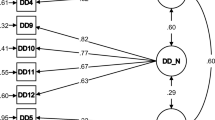Abstract
The current study examined the psychometric properties of the Turkish version of the Internalized Homophobia Scale (IHS; Herek, Cogan, Gillis, & Glunt, 1997) in gay men living in Turkey. Participants were 132 men in romantic, intimate, or sexual relationships with men, and they identified themselves as homosexual (n=112) or bisexual (n=20). Alpha and split-half reliability coefficients revealed good internal consistency of the scale. Consistent with the original scale, the construct validity revealed a single factor for the scale. Regarding convergent validity, the IHS had significant correlations with psychological problems, particularly with symptoms of depression and anxiety; the scale also had a significant positive correlation with negative affect and a negative correlation with self-esteem. Regarding discriminant validity, the IHS had very low correlations with positive affect and hostility attitudes. The association between internalized homophobia and psychological problems remained significant even after controlling for the variance explained by self-esteem, negative affect, and positive affect. Hence, the psychometric properties of the Turkish version of IHS appear quite promising.
Similar content being viewed by others
References
Adam, B. (1978). The survival of domination. New York: Elsevier.
Allen, D. J., & Oleson, T. (1999). Shame and internalized homophobia in gay men. Journal of Homosexuality, 37, 33–43.
American Psychiatric Association. (1980). Diagnostic and statistical manual of mental disorders (3rd ed.). Washington, DC: Author.
Bradford, J., Caitlin, R., & Rothblum, E. (1994). National lesbian health care survey: Implications for mental health Care. Journal of Consulting and Clinical Psychology, 62, 228–242.
Cass, V. C. (1979). Homosexual identity formation: A theoretical model. Journal of Homosexuality, 4, 219–235.
Cattell, R. B. (1966). The scree test for the number of factors. Multivariate Behavioral Research, 1, 245–276.
Çuhadaroğlu, F. (1986). Adolesanlarda Benlik Saygısı [Self-esteem among adolescents]. Unpublished doctoral dissertation, Hacettepe University.
Derogatis, L. R. (1992). The Brief Symptom Inventory: Administration, scoring and procedures manual-II. Baltimore: Clinical Psychometric Research Inc.
Firestone, R. W. (1987). The ‘voice’: The dual nature of guilt reactions. American Journal of Psychoanalysis, 47, 210–229.
Friedman, R. C., & Downey, J. I. (1999). Internalized homophobia and gender valued self-esteem in the psychoanalysis of gay patients. Psychoanalytic Review, 86, 325–347.
Gençöz, T. (2000). Pozitif ve Negatif Duygu Durum Ölçeği: Geçerlik ve güvenirlik çalışması [Positive and Negative Affect Schedule: A study of validity and reliability]. Türk Psikoloji Dergisi, 15, 19–28.
Gençöz, T. (2002). Discriminant validity of low positive affect: Is it specific to depression? Personality and Individual Differences, 32, 991–999.
Herek, G. M., Cogan, J. C., Gillis, J. R., & Glunt, E. K. (1997). Correlates of internalized homophobia in a community sample of lesbians and gay men. Journal of the Gay and Lesbian Medical Association, 2, 17–25.
Kağıtçıbaşı, Ç. (1987). Individual and group loyalties: Are they compatible? In Ç. Kağıtçıbaşı (Ed.), Growth and progress in cross-cultural psychology (pp. 94–104). Lisse, Netherland: Swets and Zeitlinger.
Kağıtçıbaşı, Ç. (1990). Family and socialization in cross-cultural perspective. Nebraska Symposium on Motivation, 37, 135–200.
Kahn, M. (1991). Factors affecting the coming out process for lesbians. Journal of Homosexuality, 21, 47–70.
Lewis, R. J., Derlega, V. J., Griffin, J. L., & Krowinski, A. C. (2003). Stressors for gay men and lesbians: Life stress, gay-related stress, stigma consciousness, and depressive symptoms. Journal of Social and Clinical Psychology, 22, 716–729.
Lima, G. L., Presto, C. T., Sherman, M. F., & Sobelman, S. A. (1993). The relationship between homophobia and self-esteem in gay males with AIDS. Journal of Homosexuality, 25, 69–76.
Meyer, I. H. (1995). Minority stress and mental health in gay men. Journal of Health and Social Behavior, 36, 38–56.
Miranda, J., & Storms, M. (1989). Psychological adjustment of lesbians and gay men. Journal of Counseling and Development, 68, 41–45.
Nungesser, L. G. (1983). Homosexual acts, actors, and identities. New York: Praeger.
Ratti, R., Bakeman, R., & Peterson, J. L. (2000). Correlates of high risk sexual behaviour among Canadian men of South Asian and European origin who have sex with men. AIDS Care, 12, 193–203.
Rosenberg, M. (1965). Society and adolescent self-image. Princeton, NJ: Princeton University Press.
Ross, M. W., & Rosser, B. R. (1996). Measurement and correlates of internalized homophobia: A factor analytic study. Journal of Clinical Psychology, 52, 15–21.
Şahin, N. H., & Durak, A. (1994). Kısa Semptom Envanteri: Türk gençleri için uyarlanması [Brief Symptom Inventory: Adaptation for Turkish youth]. Türk Psikoloji Dergisi, 9, 44–56.
Shidlo, A. (1994). Internalized homophobia: Conceptual and empirical issues in measurement. In B. Greene & G. M. Herek (Eds.), Psychological perspectives on lesbian and gay issues (pp. 176–205). Thousand Oaks, CA: Sage.
Troiden, R. R. (1989). The formation of homosexual identities. Journal of Homosexuality, 17, 43–74.
Watson, D. (1988). The vicissitudes of mood measurement: Effects of varying descriptors, time frames, and response formats on measures of positive and negative affect. Journal of Personality and Social Psychology, 54, 1020–1030.
Watson, D., Clark, L. A., & Tellegen, A. (1988). Development and validation of brief measures of positive and negative affect: The PANAS scales. Journal of Personality and Social Psychology, 54, 1063–1070.
Watson, D., & Tellegen, A. (1985). Toward a consensual structure of mood. Psychological Bulletin, 98, 219–235.
Acknowledgement
This work was partially supported by the Turkish Academy of Sciences, in the framework of the Young Scientist Award Program (TG-TÜBA-GEBİP/2002–1-11).
Author information
Authors and Affiliations
Corresponding author
Rights and permissions
About this article
Cite this article
Gençöz, T., Yüksel, M. Psychometric Properties of the Turkish Version of the Internalized Homophobia Scale. Arch Sex Behav 35, 597–602 (2006). https://doi.org/10.1007/s10508-006-9063-1
Published:
Issue Date:
DOI: https://doi.org/10.1007/s10508-006-9063-1




